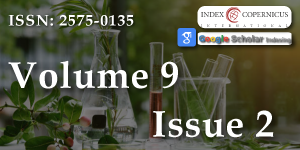Obtaining Synthetic Polyploid Sources through Hybridization of Diploid Species of Gossypium L. and Their Cytological Analysis
Main Article Content
Abstract
The wild diploid species Gossypium anomalum is considered a promising
genetic resource for improving the genetic traits of cultivated cotton varieties due
to its natural adaptation to abiotic (e.g., drought, high temperatures) and biotic (e.g.,
insects, diseases) stress conditions. Due to the challenges in hybridizing cultivated
tetraploid and wild diploid species, the genome of the F1 generation, obtained
from the hybridization of wild species G. herbaceum subsp. pseudoarboreum
(A1 genome) and Gossypium anomalum (B1 genome), was amplifi ed through
synthetic polyploidy to restore crossbreeding fertility. Cytogenetic analysis of F1С
hybrids revealed unbalanced tetrads and abnormal dyads during sporogenesis.
These anomalies, resulting from genetic differences between the species, negatively
impacted the fertility of the hybrids. Additionally, disturbances in chromosome
distribution during microsporogenesis were observed, leading to reduced viability of
pollen grains in hybrid plants. Based on these fi ndings, it was concluded that further
breeding efforts are necessary to enhance the genetic stability and restore the
fertility of these hybrids.
Article Details
Copyright (c) 2025 Xolova M.

This work is licensed under a Creative Commons Attribution 4.0 International License.
1. De Storme N, Geelen D. High temperatures alter cross-over
distribution and induce male meiotic restitution in Arabidopsis
thaliana. Commun Biol. 2020;3(1):187. Available from: https://
doi.org/10.1038/s42003-020-0897-1
2. Lei X, Ning Y, Eid Elesawi I, Yang K, Chen C, Wang C, Liu B.
Heat stress interferes with chromosome segregation and
cytokinesis during male meiosis in Arabidopsis thaliana. Plant
Signal Behav. 2020;15(5):1746985. Available from: https://doi.or
g/10.1080/15592324.2020.1746985
3. Yeung EC, Oinam GS, Yeung SS, Harry I. Anther, pollen and
tapetum development in saffl ower, Carthamus tinctorius L.
Sex Plant Reprod. 2011;24(4):307–317. Available from: https://
doi.org/10.1007/s00497-011-0168-x
4. Kaur K, Gupta RC, Kumari S. Cyto-morphological studies
of some dicot plants from Rajasthan (India). Cytologia.
2015;80:353–362. Available from: http://dx.doi.org/10.1508/
cytologia.80.353
5. Russo G, Krauss M. Septin remodeling during mammalian
cytokinesis. Front Cell Dev Biol. 2021;9:768309. Available from:
https://doi.org/10.3389/fcell.2021.768309
6. Jäger K, Fábián A, Barnabás B. Effect of water defi cit and
elevated temperature on pollen development of drought
sensitive and tolerant winter wheat (Triticum aestivum L.)
genotypes. Acta Biol Szeged. 2008;52:67–71. Available from:
https://abs.bibl.u-szeged.hu/index.php/abs/article/view/2583
7. Pausheva ZP. Practical training in plant sitology. Method.
Manual. Moscow: Agropromizdat; 1980.

